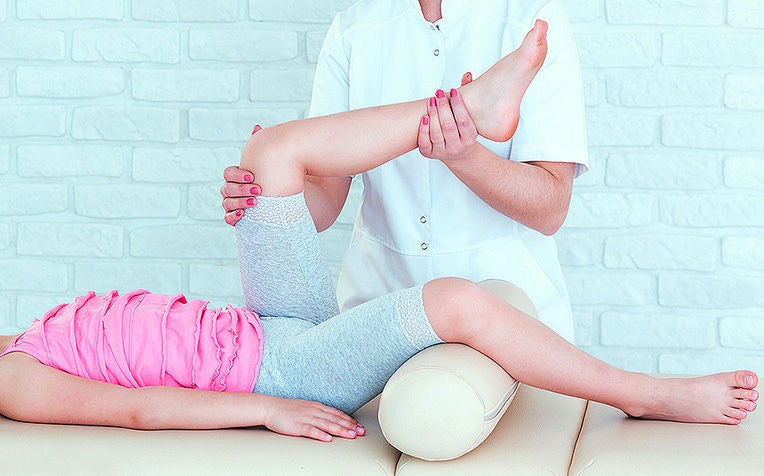
(Passive) Lower limb stretching exercises help to maintain flexibility or range of movement in the lower limb joints.
Stretching exercises or range of motion (ROM) exercises are important to maintain flexibility or range of movement in the lower limb joints. It also assists with overall circulation and creates awareness of the lower limbs.
The following exercises serve as a guide to the various stretches of the lower limb. Do ensure that you have been taught the recommended exercises and exercise regime (i.e. number of repetitions / sets and exercise frequency) by your child’s Physiotherapist before carrying them out.
Safety precautions when exercising
Ensure your child is positioned comfortably
Keep your movements slow to allow muscles to relax; moving quickly may increase stiffness
Do not force the movement if the muscle or joint is stiff – move the joint within the safe range as recommended by your therapist
Observe for signs of pain or discomfort – stop if pain occurs, and check in with your therapist before continuing further
Your exercise regime
![]() Each stretching exercise should be repeated
5-10 times
Each stretching exercise should be repeated
5-10 times
![]() Hold the stretch at the end for
20-30 seconds
Hold the stretch at the end for
20-30 seconds
![]() Repeat exercises
every day – check in with your therapist on the recommended number of sets per day
Repeat exercises
every day – check in with your therapist on the recommended number of sets per day
Passive stretches
Hip | |
|---|---|
Passive hip flexor and quadriceps stretch Aim: To stretch tight tissue over the child’s anterior thigh and knee with the assistance of a caregiver. Instruction: Position the child lying on their tummy with the knee bent. Place your hands on the front of the child’s thighs while cradling the knee, while another hand supports the lower back. Gentle lift the knee away from the supporting surface, applying a gentle stretch on the front of the child’s thigh. Ensure the hip does not roll in or out. | /passive-hip-flexor-and-quadriceps-stretch.jpg) |
Passive hip adductor stretch Aim: To stretch tight tissue over your inner thighs and knees with the assistance of a caregiver. Instruction: Position the child lying on the back with hips and knee straight. Place your hands on the side of his / her thighs and gently move the lower limb towards you, applying a gentle stretch on the child’s inner thigh muscles. Ensure the hip does not roll in or out. Try to keep the other leg in a neutral position. Precautions: Take care when stretching tight tissue around the inner thigh as excessive stretch or overpressure may cause tearing of the thin tissue around the inner thigh. Stop the exercise and check with your physiotherapist if you notice that your child is in pain during the stretch. | /passive-hip-adductor-stretch-a.jpg) /passive-hip-adductor-stretch-b.jpg) |
Knee | |
Passive supine hamstring stretch Aim: To stretch or maintain length of the muscles at the back of the child’s thighs (hamstrings) with the assistance of a caregiver. Instructions: Position the child lying on back with hip and knee bent. Place your open palm on the child’s thigh and calves. Gently lift the child’s leg to straighten the knee as much as possible. The child should feel a gentle stretch in the back of thigh. Precautions:
| |
Ankle | |
Prone soleus stretch Aim: To stretch or maintain range of the child’s calf muscles. Instructions: Position the child lying down on tummy. Place your hand around the child’s heel with your palm along the length of the foot and gently push the foot downwards with the knees bent. Ensure that the ankle does not roll in or out. | /prone-soleus-stretch.jpg) |
Supine soleus stretch Aim: To stretch or maintain range in child’s calf muscles. Instructions: Position the child lying down on the back. Place your hand around the child’s heel with your palm along the length of the foot and gently push the foot upwards with the knees bent. Ensure that the ankle does not roll in or out. | /supine-soleus-stretch.jpg) |
Supine gastrocnemius stretch Aim: To stretch or maintain range of thechild’s calf muscles. Instructions: Position the child lying on the back with your hand stabilising the knee. Place your other hand around the child’s heel with your palm along the length of the foot and gently push the foot upwards with the knees straight. Ensure that the ankle does not roll in or out. Precautions:
| |
Ref: K21
Check out other articles on seizure and epilepsy in children:
Epilepsy and Seizures: Causes, Types and How to Manage
Seizure and Epilepsy Action Plan
Epilepsy: Treatment and Diet Tips
Child Neurological Conditions: Care Tips Resource












/passive-supine-hamstring-stretch-a.jpg)
/passive-supine-hamstring-stretch-b.jpg)
/supine-gastrocnemius-stretch.jpg)





 Get it on Google Play
Get it on Google Play